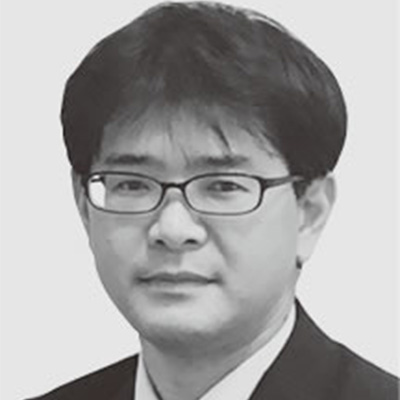The most recent developments that have been affecting Japan’s power grids are the establishment of OCCTO, the full liberalization of the retail market, the large-scale introduction of renewable energy such as photovoltaic and wind power, and efforts to maintain and update aging power distribution equipment. Hitachi has been working on various transmission and distribution sector technologies related to these developments. These activities include work on HVDC projects and voltage source converters to enhance nationwide system operation in Japan, developing PMU data-driven solutions for stabilizing advanced wide-area grids, work on SCADA/EMS and DMS systems that extend the life of power transmission and distribution equipment, and work on creating fully digital OT- and IT-driven substations.

Power System Information & Controls Business Division, Energy Solutions Business Unit, Hitachi, Ltd. Current work and research: Business development of electric power grid stabilization systems. Society memberships: Certified P.E.Jp (Professional Engineer, Japan).

Power Electronics Systems Department, Power System Information & Controls Business Division, Energy Solutions Business Unit, Hitachi, Ltd. Current work and research: Business development of HVDC transmission systems. Society memberships: IEEJ, and the International Council on Large Electric Systems (CIGRE).

Energy Management Systems Research Department, Center for Technology Innovation – Energy, Research & Development Group, Hitachi, Ltd. Current work and research: Development of electric power system stabilization systems. Society memberships: IEEE and CIGRE.

Power Systems Engineering Department, Control System Platform Division, Services & Platforms Business Unit, Hitachi, Ltd. Current work and research: Development and design consolidation of power grid monitoring and control systems.

Power System Information & Controls Business Division, Energy Solutions Business Unit, Hitachi, Ltd. Current work and research: Business development of general transmission and distribution solutions. Society memberships: IEEJ.
Since the Great East Japan Earthquake, electricity reforms have been progressing in Japan. These reforms have three objectives—securing a stable supply of electricity, suppressing electricity rates to the maximum extent possible, and expanding choices for consumers and business opportunities. Stage 1 of the reforms came in FY2015, when the Organization for Cross-regional Coordination of Transmission Operators, Japan (OCCTO) was established to expand wide-area grid operation. Stage 2 came in FY2016 with the full liberalization of electricity retailing. Stage 3 is planned for FY2020, when the legal unbundling of the transmission and distribution sectors will be used to ensure greater neutrality for the transmission and distribution sectors. And, to combat global warming (an issue of worldwide concern), the large-scale introduction of photovoltaic and wind power is being accelerated through a feed-in tariff (FIT) system. The power output generated by these renewable energy is affected by weather, so large fluctuations in that output have an impact on stable grid operation.
The key challenges involved in suppressing electricity rates will be improving business efficiency in areas such as operation and maintenance to further lower tariffs in the transmission and distribution sectors, and expanding power distribution through interconnecting lines that enable the operation of highly efficient generators on a nationwide scale. Moreover, electricity has become essential to social activity and to daily life, so it is important to maintain a stable supply of it on wide-area grids along with its cost-effectiveness.
The following chapters of this article present solutions that Hitachi, Ltd. is working on to respond to these key challenges by combining the operational technology (OT) and information technology (IT) it has accumulated over its history. These solutions address the issues of wide-area grid interconnection, power grid stabilization, supervisory control and data acquisition (SCADA) systems, energy management systems (EMSs), distribution management systems (DMSs), and the full digitalization of substations.
The Great East Japan Earthquake on March 11, 2011 caused the loss of many large-scale power sources in the Tohoku and Tokyo power control areas. If there were higher capacities available for interconnecting grids between other areas and east-west frequency converter equipment, it might have reduced the number of planned outages after the earthquake and avoid them.
The result of the disaster was an increase in demand for wide-area grid operation under a supply system spanning multiple control areas, instead of the conventional approach, which is based mainly around satisfying the power supply and demand of each individual power control area. An essential requirement to enable this approach is to increase the interconnection capacity between control areas, including interconnection between areas with different frequencies.
However, when interconnecting two control areas with AC transmission lines, problems arise such as bypass current generation, effects on peripheral equipment from increasing short-circuit current, and grid faults in one grid affecting another grid. High-voltage direct current (HVDC) is the leading interconnection technology used to avoid these problems. HVDC reduces transmission loss during long-distance power transmission and enables direct interconnection of grids with different frequencies.
A national review board and other organizations are currently creating plans to upgrade the grid connection capacity between the control areas of Tokyo Electric Power Company Holdings, Incorporated (TEPCO) and Chubu Electric Power Co., Inc. The upgrade will increase the interconnection capacity from the current 1,200 MW to 3,000 MW. It will enable maximum use of large-scale power sources in the 50 Hz area and 60 Hz area, enabling responses to supply shortage risks immediately after major disasters. In upgrading the interconnection between the Tokyo and Chubu grids, a 900 MW HVDC project is underway to connect the Shin-Shinano and Hida frequency converter stations. Hitachi has been hired to work on the 60 Hz Hida station. There are also plans to upgrade the Sakuma Frequency Converter Station to 300 MW, and the Higashi-Shimizu Substation to 600 MW(1).
There are two types of HVDC converters—line commutated converters and voltage source converters. All previous projects in Japan have used line commutated converters. But research on HVDC voltage source converters has been growing worldwide since around the year 2000, and these converters have been used in several projects outside Japan.
HVDC voltage source converters impose fewer restrictions on the grids that are interconnected or on operation, and they also allow independent control of active power and reactive power, which provides grid stabilization benefits. Although the converters themselves are more expensive than line commutated converters, they can enable smaller filters and phase modifying equipment, the use of cheaper and lighter cables, and reduce grid connection costs compared with line commutated converters. The total costs can therefore be kept the same or less than the costs of HVDC line commutated converters. Voltage source converters are also effective in reducing the installation footprint (see Table 1)(2).
Due to these benefits, HVDC voltage source converters have been selected for the 300-MW upgrade of the Sakuma Frequency Converter Station and the 600-MW upgrade of the Higashi-Shimizu Substation.
To respond to this rapidly growing demand for HVDC voltage source converters, Hitachi has co-founded Hitachi ABB HVDC Technologies, Ltd. (HAB), a joint-venture with ABB for work on HVDC projects in Japan. HAB began operating in November 2015(3). ABB developed HVDC technology about 60 years ago, and its state-of-the-art technology has continually kept it a global leader in HVDC projects. ABB has an impressive track record in HVDC voltage source converters, helping complete 14 of the 15 completed sites that use them worldwide(4).
HAB and Hitachi are partnering to work on the HVDC project currently underway to connect the Shin-Shinano and Hida stations. HAB should help secure a stable wide-area power supply in Japan by combining Hitachi’s wealth of experience in Japanese power grids with ABB’s world-class leading-edge in HVDC technology.
Table 1 — Comparison of HVDC Line Commutated Converter and HVDC Voltage Source Converter
 The HVDC voltage source converter has advantages in areas such as operation, cost-effectiveness, and grid stabilization benefits.
The HVDC voltage source converter has advantages in areas such as operation, cost-effectiveness, and grid stabilization benefits.
Figure 1 — Example HVDC Applications
 The demand for HVDC voltage source converters continues to grow for connecting renewable energy to grids, long-distance power transmission, and pooling between grids.
The demand for HVDC voltage source converters continues to grow for connecting renewable energy to grids, long-distance power transmission, and pooling between grids.
Demand for HVDC will continue to grow in the future as it enables large-scale introduction of renewable resources, long-distance power transmission to high-demand areas, and increasing interchange power between control areas. HVDC voltage source converters are particularly promising for the grid stabilization benefits they provide.
Hitachi is looking toward the application of HVDC voltage source converters in areas such as subsea cable power transmission for offshore wind power energy, wind power and mega photovoltaic power generation in remote locations, and in the connection of outlying islands or other enclaves to grids (see Figure 1).
This section presents the phasor measurement unit (PMU)-based power grid operator assistance system that Hitachi is working on as part of its work on power grid stabilization solutions(5).
With the increase of renewable energy and introduction of wide-area grid operation (as part of Japan’s deregulation), Japan’s need for power grid stabilization is rapidly growing. The complexity of stable power grid operation is becoming unprecedented as the transition is being made from centralized power sources to distributed power sources. In the future, this is likely to cause new power flow patterns that were not traditionally seen.
As similar changes are occurring globally, power grid operators around the world are focusing on PMUs as a method to overcome this challenge. A PMU is a device that measures the power grid using synchronized timestamps. Compared to traditional devices in the power grid (SCADA), which reported measurements at a rate of 0.5 Hz, a PMU reports measurements at 10~120 Hz(6): giving high-resolution insight into the power grid over a wide area. Due to this quality of the PMU, over 2,000 PMUs are now installed across the North American power grid. Active discussions are currently being held on usage in actual power grid operation(7).
Looking ahead to the global spread of PMUs, Hitachi is developing a PMU-based power grid operator assistance system. The following section presents the details behind the development.
One example of a contingency that occurs as a result of the trend in power grid operation is known as a wide-area power oscillation. Wide-area power oscillations occur when an external disturbance like a lightning strike trigger uncoordinated emergency control of generators across a grid. Such uncoordinated control brings the power system to a vulnerable state in which outages are more likely to happen. When left untreated or even mistreated with improper control, wide-area power oscillations can eventually lead to an outage. For example, wide-area power oscillations have been identified in the Northeast blackout of 2003(8): a massive power grid failure that caused up to $6 billion (USD) in damage(9).
The development of the power grid operator assistance system aims to assist operators in these contingencies. The system leverages a strong IT platform to realize a concept called “know-how retrieval” from archive data. Figure 2 shows a functional overview of the system. First, the system gathers information about the power grid through a network of PMU data. Then, the system identifies events that may affect stable operation of the power system. After an event is detected, techniques such as regression analysis and oscillation analysis are then performed to extract the features of the event in a vector form; the features are then used to form a cluster of similar events (α, β,.....) to create an event categorization table through the use of machine learning. The created event categorization table is then stored in a high-speed database* along with past PMU data and the operations logs associated with the events. Over time, the event categorization table accumulates power grid operation “know-how” in the data, and allows presentation of this know-how when similar events occur. Figure 3 shows an example of the graphical user interface (GUI) that a power grid operator would see.
This technology enables operators to incorporate the know-how of the past with the use of a high-speed database. As a result, operators are able to operate the power grid more reliably, which allows the mitigation of major power grid failures.
In terms of power transmission and distribution systems, Hitachi is studying how to build systems for greater business efficiency that can flexibly adapt to improvements, and be integrated with existing systems and changing business procedures. These systems will be adaptable to a stable supply of electricity enabled by wide-area grid operations that incorporate business continuity plan (BCP) contingency measures.
Since much of Japan’s existing power distribution equipment was built during the country’s economic boom and bubble years, it is confronted by the key issues of updating this equipment while extending its useful life.
Given this background, this section presents some of the functions that SCADA, EMS and DMS systems will require.
SCADA/EMS systems are extremely important systems for the stable operation of high-voltage transmission systems.
During events such as major earthquake disasters, there needs to be a continuous supply of stable power even if control centers have been affected. Wide-area backup configuration systems are being studied and implemented that have monitoring and control servers installed at two different locations to ensure business continuity (see Figure 4).
The advance of system integration designed to improve business efficiency is resulting in operators having to monitor and control more equipment than before, so SCADA/EMS systems need to provide operators with work assistance functions. There is a need for functions that automatically control substation secondary voltages, and for functions designed to predict efficient measures for contingency scenarios on selected grid equipment.
Figure 4 — Wide-area Backup Configuration Between Adjacent Control Centers
 Servers are installed in two adjacent control centers, providing mutual backup.
Servers are installed in two adjacent control centers, providing mutual backup.
DMSs monitor and control pole-mounted automatic remote control switches to improve power distribution business efficiency and to enable rapid restoration after contingencies. In the future, however, grids will need to be operated while managing voltages with many different types of distributed power sources connected to distribution networks.
With high public demand for a safe and stable supply of electricity, many functions will likely be demanded from systems in the future. These functions will be needed for objectives such as maintaining supply reliability, improving power distribution business efficiency, enabling more advanced detection of fault location, and office integration and mutual backup to support BCP.
The following section presents an overview of future functions for power distribution automation that will lead to overall efficiency of the power distribution business. These functions will be driven by data such as grid measurement information gathered by next-generation DMSs (see Figure 5).
A distribution load database consisting of pole-mounted sensor switch measurement information gathered by the DMS will be created. Measurement information from a meter data management system (MDMS) will be used to improve the detail of load information. Equipment information from distributed power sources will also be managed to keep track of the distribution load information and voltage profile while accounting for the distributed power sources.
Supplying this information for the design of distribution equipment enables the installation of proper capacity equipment that conforms to the actual load conditions. When updating aging equipment, past load states could be used to identify and estimate current and future loads to enable more streamlined equipment.
Managing installation locations of distributed resources, equipment, and loads will also enable equipment maintenance based on the operating conditions.
This section has described some of the functions that will be needed by SCADA, EMS, and DMS systems in the future.
Figure 5 — Improving Power Distribution Business Efficiency by Adding Distribution Server Systems Sharing Mutual Information
 A distribution load database is created from next-generation DMS system grid measurement information and MDMS system measurement information, and is used to increase power distribution business efficiency.
A distribution load database is created from next-generation DMS system grid measurement information and MDMS system measurement information, and is used to increase power distribution business efficiency.
The transmission and distribution sectors (consisting of general electric utilities) is being called on to further lower wheeling charges in advance of the sectors’ legal unbundling in 2020. One of the issues facing the sectors is the maintenance and replacement of aging transmission and distribution equipment that expanded during the rapid economic growth period.
In the future, considering declining power demand, the transmission and distribution sectors will need to shift emphasis from the construction of new equipment to the maintenance and replacement of equipment, and need to work to further improve business efficiency through streamlining assets, extending their lifetime, and more sophisticated maintenance. To enable business-enhancing strategic equipment planning and operation, these sectors will likely work on full digitalization of power transmission and distribution assets driven by IT. Drawing on its strengths in both OT and IT, Hitachi will work to address these needs by providing comprehensive solutions that use IT to organically manage maintenance information and grid monitoring information from the primary equipment installed in substations (see Figure 6).
These solutions need to be built in ways that will achieve seamless information connection with the transmission and distribution equipment that make up a power system, to enable the solutions to flexibly adapt to future service area expansion and operation center changes or consolidation in line with organizational changes. These approaches will call for architecture designed to incorporate international standards providing outstanding interoperability between systems (see Figure 7).
To accomplish full digitalization of substations, Hitachi is planning to model interoperable systems that conform to international standards, of which the following three items are typical examples, and to demonstrate communication methods.
For the supervisory control and monitoring of the transmission and distribution sectors, Hitachi is drawing on the OT and IT strengths it has accumulated over its history to pursue digitalization in the transmission and distribution business sector, thereby providing new value that is aligned with the Internet of Things (IoT) era. Hitachi will continue to provide solutions, not only in the form of products, but also in the form of systemization and services.